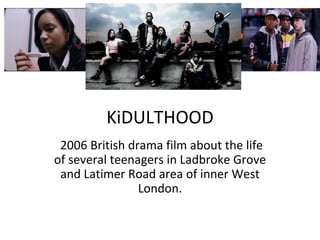Kidulthood presentation
- 1. KiDULTHOOD 2006 British drama film about the life of several teenagers in Ladbroke Grove and Latimer Road area of inner West London.
- 2. GENRE We can see from the uniform that the characters are in school. URBAN DRAMA A narrative with a city backdrop, usually dealing with issues such as crime, drugs, poverty etc. The introduction of the character of Sam is crucial. Firstly, costume is used to differentiate him from others in the scene. Whilst otherâs wear a school uniform, Sam is seen wearing a blue hoody and jeans. His hoody is zipped all the way up and the hood over his head. This alludes to a sense of mystery and danger, and makes you question what his motives are for being in a school playground.
- 3. GENRE URBAN DRAMA The use of the drill connotes danger. Trevor wears protective glasses, which suggests that he himself may come across harm. The location of the school playground is used as a base to introduce the different characters. It contradicts what we would expect a playground to be. Playgrounds have connotations of fun, and are supposed to be safe environments- the playground in Kidulthood is represented as the opposite of this . Â The students are involved in mischevious behaviour: bullying, smoking, drugs and sexual activity. Representations of authority also challengethe norm, it is clear the teacher has no control over the students.
- 4. GENRE URBAN DRAMA The black background on the titles suggest danger and mystery. Whilst the text, represents the âurbanâ nature of the film. The âiâ in the word âKIDULTHOODâ symbolises that whilst the characters in the film do very adult things, at heart they are still just children.
- 5. NARRATIVE -The opening sequence is fluid. The transitions are continuous, which could symbolise the movement of the plot. -Each shot is not held for longer than a few seconds. -We are given the roles of the characters, but why they are who they are is not Revealed. - Info given: They are in a school. Sam is not meant to be there. He is angry. Info held back: Who is sam? Why is he there? what is Trife doing? How will the conflict between Sam and Trife be resolved?
- 6. NARRATIVE There are several binary oppositions evident within the opening sequence: middle class vs. working class authority vs. anarchy white vs. black age vs. youth
- 7. PERSPECTIVE The opening sequence features jump cuts which convey the frenetic atmosphere in the playground. The parallel narrative features Trife modifying a gun, and helps to establish him as part of the central narrative- it is clear he is connected to the playground. Close ups, mid shots, jerky, blurry, close up on drill, People walking past camera as if someone is looking on, omnipresent viewer Parallel narrative between Adam Deacon and girl shown hiding behind a tree, separate them from the rest of the scene to demonstrate conflict between Sam
- 8. SOUND Non-diegetic sound is used to create feelings of excitement/fear, as the violence within the opening scene escalates, so the sound increases in volume and tempo. Sound- Music used in the film falls in to the genre of grime and hip-hop, attracting the target audience of young adults. Language is important- the language and dialect of the characters become a means of identification- the way the character speak is representative of their social group. Contrast this with the way Katie and the teacher speak.
- 9. WHY KiDULTHOOD? One of the first âurban dramaâs Setting of London relevant









